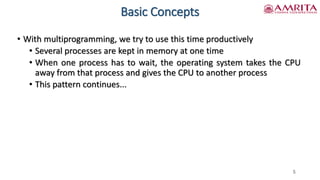CPU Scheduling Part-I.pdf
- 1. Amrita School of Engineering, Bangalore Ms. Harika Pudugosula Teaching Assistant Department of Electronics & Communication Engineering
- 2. • Basic Concepts • Scheduling Criteria • Scheduling Algorithms • Thread Scheduling • Multiple-Processor Scheduling • Real-Time CPU Scheduling • Operating Systems Examples • Algorithm Evaluation 2
- 3. Objectives CPU scheduling is the basis of multiprogrammed operating systems. By switching the CPU among processes, the operating system can make the computer more productive • To introduce CPU scheduling, which is the basis for multiprogrammed operating systems • To describe various CPU-scheduling algorithms • To discuss evaluation criteria for selecting a CPU-scheduling algorithm for a particular system • To examine the scheduling algorithms of several operating systems 3
- 4. Basic Concepts • In a single-processor system, only one process can run at a time • Others must wait until the CPU is free and can be rescheduled • The objective of multiprogramming is to have some process running at all times, to maximize CPU utilization • A process is executed until it must wait, typically for the completion of some I/O request • In a simple computer system, the CPU then just sits idle. All this waiting time is wasted; no useful work is accomplished • With multiprogramming, we try to use this time productively, maximum CPU utilization 4
- 5. Basic Concepts • With multiprogramming, we try to use this time productively • Several processes are kept in memory at one time • When one process has to wait, the operating system takes the CPU away from that process and gives the CPU to another process • This pattern continues... 5
- 6. Basic Concepts • Process execution consists of a cycle of CPU execution and I/O wait - CPU - I/O Burst Cycle • CPU Burst - when the process is being executed in the CPU • I/O Burst - when the CPU is waiting for I/O for further exection • CPU burst followed by I/O burst • Eventually, the final CPU burst ends with a system request to terminate execution 6
- 7. Histogram of CPU-burst Times 7 • An I/O-bound program typically has many short CPU bursts • A CPU-bound program might have a few long CPU bursts.
- 8. CPU Scheduler • Short-term/CPU scheduler selects from among the processes in ready queue, and allocates the CPU to one of them • Queue may be ordered in various ways • CPU scheduling decisions may take place when a process: 1. Switches from running to waiting state 2. Switches from running to ready state 3. Switches from waiting to ready 4. Terminates • For situations 1 and 4, there is no choice in terms of scheduling A new process (if one exists in the ready queue) must be selected for execution • However, there is a choice for situations 2 and 3 8
- 9. CPU Scheduler • When scheduling takes place only under circumstances 1 and 4, we say that the scheduling scheme is nonpreemptive or cooperative • Otherwise, it is preemptive • Under nonpreemptive scheduling, once the CPU has been allocated to a process, the process keeps the CPU until it releases the CPU either by terminating or by switching to the waiting state • Under preemptive scheduling, CPU has been taken away from a process, before the process has completed its execution or before it is swicting to the waiting state • Scheduling under 1 and 4 is nonpreemptive • All other scheduling is preemptive • Consider access to shared data • Consider preemption while in kernel mode • Consider interrupts occurring during crucial OS activities 9
- 10. Dispatcher • Dispatcher module gives control of the CPU to the process selected by the short-term scheduler; this involves: • switching context • switching to user mode • jumping to the proper location in the user program to restart that program • Dispatch latency – time it takes for the dispatcher to stop one process and start another running 10
- 11. Scheduling Criteria • CPU utilization – • keep the CPU as busy as possible • Conceptually, CPU utilization can range from 0 to 100 percent • In a real system, it should range from 40 percent (for a lightly loaded system) to 90 percent (for a heavily loaded system). • Throughput – • Number of processes that complete their execution per time unit • For long processes, this rate may be one process per hour • For short transactions, it may be ten processes per second • Turnaround time – • amount of time to execute a particular process • The interval from the time of submission of a process to the time of completion is the turnaround time 11
- 12. Scheduling Criteria • Turnaround time – • Turnaround time is the sum of the periods spent waiting to get into memory, waiting in the ready queue, executing on the CPU, and doing I/O • Waiting time – • The CPU-scheduling algorithm does not affect the amount of time during which a process executes or does I/O • It affects only the amount of time that a process spends waiting in the ready queue • Waiting time is the sum of the periods spent waiting in the ready queue • Response time – • amount of time it takes from when a request was submitted until the first response is produced, not output (for time-sharing environment) 12
- 13. Scheduling Algorithm Optimization Criteria • Max CPU utilization • Max throughput • Min turnaround time • Min waiting time • Min response time 13
- 14. 14 References 1. Silberscatnz and Galvin, “Operating System Concepts,” Ninth Edition, John Wiley and Sons, 2012.
- 15. 15 Thank you














